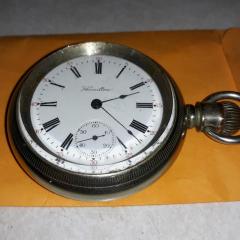-
Similar Content
-
Recently Browsing
- No registered users viewing this page.
-
Topics
-
Posts
-
By RichardHarris123 · Posted
I was wondering because of the alum idea. -
just a reminder about this test is it's not a perfect test it's a quick test. In other words you can adjust the banking pins that are both the same and visually this test will pass everything looks the same but both banking pins can be in the wrong place. although the majority of time when people are playing with banking pins I don't put them in the same place. one of things have to be careful of is I believe some of the pallet fork measuring tools that actually give you the roller jewel size are actually size so that I get confused? What I mean by this is if you inserted a whatever size in and are always told to go a slightly smaller I thought that the gauge itself its number corresponded to give you the exact number. So a lot of it depends upon the gauge itself I think you do want the roller jewel slightly smaller because it does have to fit in the slot and it does have a little bit a play. But if it's too small you will lose energy so does have to be sized right. Oh other things to check is? I'm attaching an Elgin sheet on checking the escapement I've seen references in the past to making sure that the slot in the four corn is nice and smooth and apparently you can end up with a rough slot and then the recommendation is to polisher clean that up. Not sure how well that's really going to work even if it has been the recommendation of other reference materials. yes art full plate watches fun when they don't work. This is where it's nice to have another set of eyes sometimes as maybe they'll find something you didn't although that can add other issues. The owner of the shop provides himself on his skills of so now two of my watches have relocated to his bench to solve problems both real and imaginary I'm sure that will get fixed eventually hopefully. But still sometimes another set of eyes might see something that you're not. yes this sort of thing can be quite frustrating. Also makes for an interesting problem unless of course you're the one trying to solve the problem that it's a Escapement Elgin setting up the escapement.PDF
-
I’m not to sure mate! I’ve sent a picture! The crown is off a Tissot 1853 automatic limited edition T115427 A GP19 moto go watch!
-
For years and I'm still using it I've been using something called SeaMonkey? It's a Mozilla product Basically outscore its Firefox plus an integrated email program. But not the same problems here a lot of times when things are upgraded they tend to be now aimed at very specific browsers like Firefox so I've had to switch to Firefox to respond to any of the messages on the group. So yes they do seem to be getting more browser specific and that may be a reason for others having complications especially if whatever you using hasn't been updated. So yes the world is getting more browser specific perhaps for security reasons. Even though I use a product that is updated on a regular basis is still has problems. So whatever you using for browser should be up to date and if is not recognized it's going to be a problem.
-
I did remember to ask at work and minor complication? Well I suppose technically two separate complications. First off glass mineral glass versus Seiko's Hardlex Glass. Don't know if other companies have their own class or not and a basic class for crystals is probably not the same as window glass it would be more transparent. It becomes obvious if you're looking at a sheet of flat crystal glass versus window glass it's definitely more transparent you can see it when you look at the edges of it window glass looks green. No idea how that changes physical characteristics other than optical. Then we also have thickness like the Seiko five's there crystals are really sick compared to other things and I'm guessing that makes things different. In the first link it talks about Sapphire versus mineral glass. One other thing is bothering me though when I'm reading this is where is the source material? What I mean by this is could we end up with multiple generations of salespeople quoting the same sales tactic or information and we don't actually know because you don't have a source reference? Let me quote something off the website it's brittle oh dear I was sad? Except it's not immune to damage it can crack where shatter under extreme force or impact. So what is the definition of extreme force or impact? Then is that more or less extreme then mineral glass? Then regarding the price difference while back I had asked the owner where the Sapphire came from and basically wherever he can get the cheapest. So typically ordered from a variety of online supply watch parts in the US and aliexpress China.. Then yes it does make a difference because we go through a lot of glass crystals and sapphire https://thehorologylab.com/sapphire-crystal-vs-mineral-glass-which-is-best-for-your-watch#google_vignette Then I guess one is glass not glass when it goes by another name? Hardlex Looks like it's purely a Seiko product but now I wonder if other watch companies have their own special glass? I didn't remember from past experience my favorite was people exposed to welding you can find little blobs a metal stuck to the watch case the crystal still intact but there's little burnt holes were bits of metal had actually burnt into the crystal but it was still there. Okay website below starts off with Sapphire sounds good but Apparently it can shatter easier then Hardlex. https://theslenderwrist.com/hardlex-crystal/ One other thing is what I'm reading to websites would be back to I want to see the test results? Often times weren't looking for a subject will find websites where I basically called them these are better than that by the way but sometimes I'll find websites that I will call book review websites were basically the review other websites other material and don't really introduce anything new to the subject. As I said these websites look quite nice which is why I'm giving you a link but where's the test results the definition of extreme how extreme to break a sapphire versus a glass or Hardlex?
-










Recommended Posts
Join the conversation
You can post now and register later. If you have an account, sign in now to post with your account.
Note: Your post will require moderator approval before it will be visible.